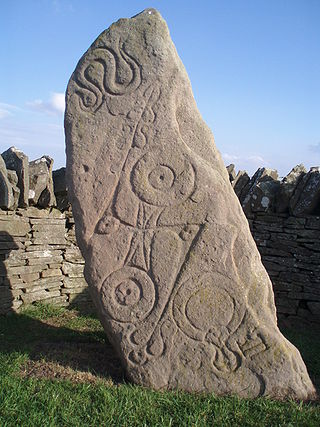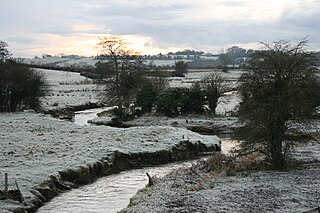
A passage grave or passage tomb consists of one or more burial chambers covered in earth or stone and having a narrow access passage made of large stones. These structures usually date from the Neolithic Age and are found largely in Western Europe. When covered in earth, a passage grave is a type of burial mound which are found in various forms all over the world. When a passage grave is covered in stone, it is a type of cairn.

The Hill of Tara is a hill and ancient ceremonial and burial site near Skryne in County Meath, Ireland. Tradition identifies the hill as the inauguration place and seat of the High Kings of Ireland; it also appears in Irish mythology. Tara consists of numerous monuments and earthworks—dating from the Neolithic to the Iron Age—including a passage tomb, burial mounds, round enclosures, a standing stone, and a ceremonial avenue. There is also a church and graveyard on the hill. Tara forms part of a larger ancient landscape and Tara itself is a protected national monument under the care of the Office of Public Works, an agency of the Irish Government.

Rathcroghan is a complex of archaeological sites near Tulsk in County Roscommon, Ireland. It is identified as the site of Cruachan, the traditional capital of the Connachta, the prehistoric and early historic rulers of the western territory. The Rathcroghan Complex is a unique archaeological landscape with many references found in early Irish medieval manuscripts.

Ogham is an Early Medieval alphabet used primarily to write the early Irish language, and later the Old Irish language. There are roughly 400 surviving orthodox inscriptions on stone monuments throughout Ireland and western Britain, the bulk of which are in southern Munster. The largest number outside Ireland are in Pembrokeshire, Wales.

Sculptured stones is a name applied to carved stone monuments from the early Christian period excavated in various parts of the British Isles and Scandinavia. They document the conversion of these areas to Christianity.

Roughly 400 inscriptions in the ogham alphabet are known from stone monuments scattered around the Irish Sea, the bulk of them dating to the fifth and sixth centuries. The language of these inscriptions is predominantly Primitive Irish, but a few examples are fragments of the Pictish language. Ogham itself is an Early Medieval form of alphabet or cipher, sometimes also known as the "Celtic Tree Alphabet".

A cillín is a historic burial site in Ireland, primarily used for stillborn and unbaptized infants. These burial areas were also used for the recently deceased who were not allowed in consecrated churchyards, including the mentally disabled, suicides, beggars, executed criminals, and shipwreck victims.

Tibradden Mountain is a mountain in County Dublin in the Republic of Ireland. Other former names for the mountain include "Garrycastle" and "Kilmainham Begg". It is 467 metres high and is the 561st-highest mountain in Ireland. It forms part of the group of hills in the Dublin Mountains which comprises Two Rock, Three Rock, Kilmashogue and Tibradden Mountains. The views from the summit encompass Dublin to the north, Two Rock to the east and the Wicklow Mountains to the south and west.

Two Rock is a mountain in Dún Laoghaire–Rathdown, Ireland. It is 536 metres high and is the 382nd highest mountain in Ireland. It is the highest point of the group of hills in the Dublin Mountains which comprises Two Rock, Three Rock, Kilmashogue and Tibradden Mountains. The mountain takes its name from the two granite tors that lie to the south-east of the summit. From the summit, which is called Fairy Castle, there are views of much of the Dublin area from Tallaght to Howth to the north while Bray Head, Killiney Hill, the Great Sugar Loaf and the Wicklow Mountains are visible to the south. The summit area is mostly shallow bog while ferns and gorse cover the lower slopes. The mountain is also an important habitat for red grouse.
Jews' Gate Cemetery is a Jewish cemetery located on Windmill Hill within a nature reserve in the British Overseas Territory of Gibraltar. Also known as the Windmill Hill Cemetery, it is the site of the earliest known Jewish burials in Gibraltar. The cemetery opened by 1746 and closed in 1848. It is the burial site of a number of Gibraltar's Chief Rabbis. The graveyard is protected by the law of Gibraltar.

Kilbride, or Manor Kilbride, is a village, civil parish and electoral division in County Wicklow, Ireland, located at the western edge of the Wicklow Mountains in the barony of Talbotstown Lower.

The Silchester Ogham stone is a pillar stone discovered at the Roman town on Calleva Atrebatum in Silchester, Hampshire during excavations in 1893. Thus far it remains the only one of its kind found in England, and the only ogham inscription in England east of Cornwall and Devon. The stone is held in a storage facility of Reading Museum in Reading, Berkshire.

The River Greese is a small, fast-flowing river in south-east, Ireland, and a tributary of the River Barrow.
Ballintaggart Ogham Stones is a collection of ogham stones forming a National Monument located in County Kerry, Ireland.

Ratass Church is a medieval church with ogham stone inscriptions in Tralee, County Kerry, Ireland. It is a National Monument.
The Tullygarran ogham stones are a pair of ogham stones forming a National Monument located in County Kerry, Ireland.

Kilcoolaght East Ogham Stones are a collection of ogham stones forming a National Monument located in County Kerry, Ireland.

Ballywiheen is a medieval Christian site and National Monument located on the Dingle Peninsula, Ireland.
Dubhán was a priest and possibly a bishop. He was of the Lagenians and brother of Damán, of Cluain Foda, in Fíodh-mór. Dubhán was of the Dál Cormaic, and also brother to St. Abbán moccu Corbmaic.

Knock y Doonee is a significant historical and archaeological site in the parish of Andreas on the northern coast of the Isle of Man. The site has been in ritual use for centuries. Archaeological excavations have uncovered a Christian keeill with a bilingual ogham stone and a Christian carved stone cross; and on a nearby hilltop a Viking Age boat burial.















